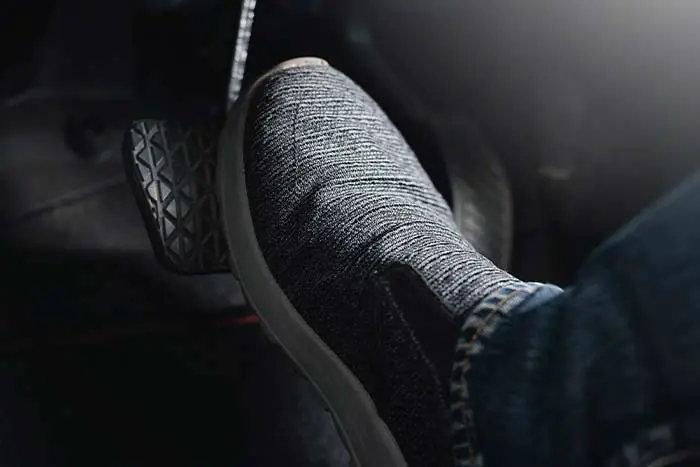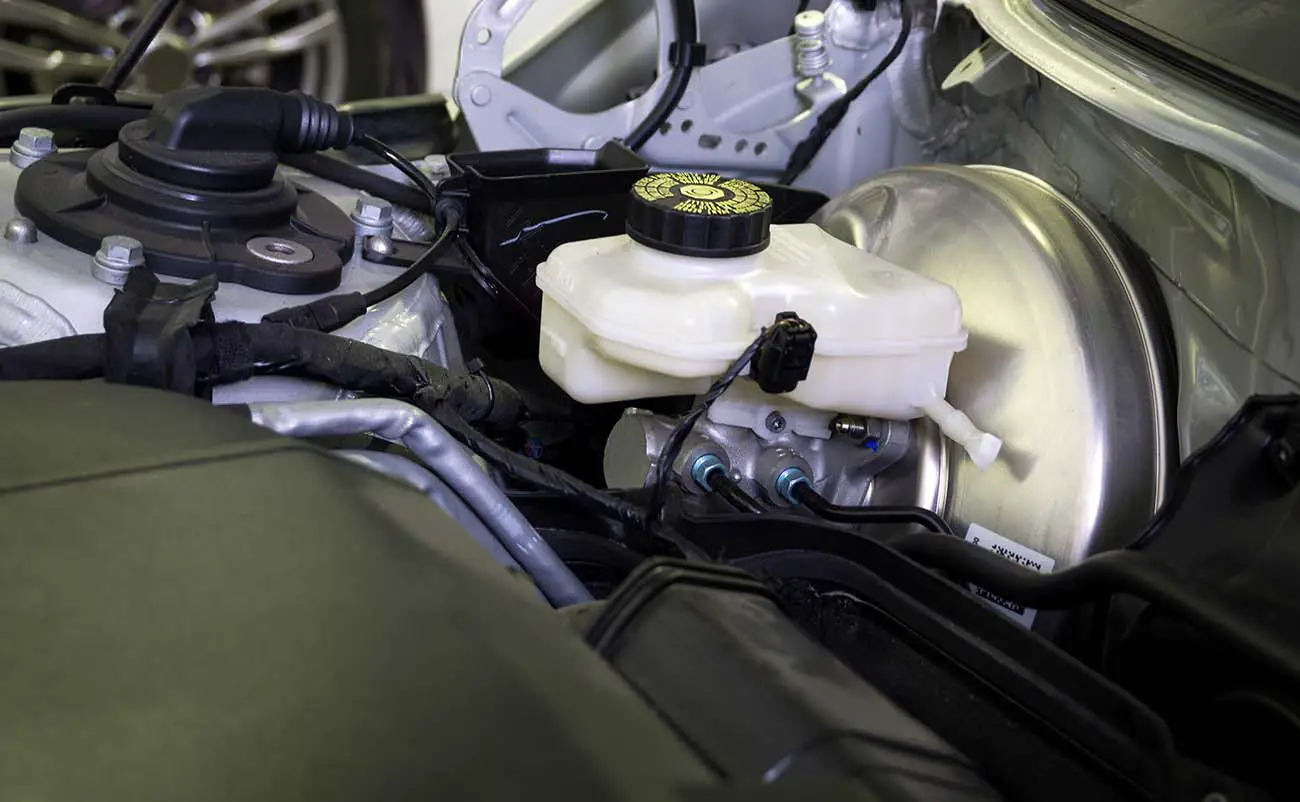When you press your car’s brake pedal, you expect the vehicle to stop. The master cylinder is a crucial element of the car’s braking system, and without the master cylinder, the car would not stop properly. Even though the master cylinder is relatively small, it is pretty complex and performs an essential job. If this part starts to experience problems, you will certainly notice them right away as you drive your vehicle. In fact, you should not drive the vehicle until the brake master cylinder has been repaired or replaced. Keep reading as we tell you exactly what the master cylinder is, how it works, and what it takes to get it replaced.
Table of Contents
What Is A Brake Master Cylinder?
So, what is the master cylinder? Your brake master cylinder is the central piece of your car’s braking system. You can think of it as the brain or the heart of the system. The master cylinder uses the force you apply to the brake pedal, and it transfers that force to the brake calipers and brake pads at each wheel that will stop the car. The master cylinder pushes brake fluid through the brake lines and causes the caliper at each wheel to squeeze the brake rotor. This is what slows down your vehicle and causes it to stop.
Your brake master cylinder typically is the home to your brake fluid reservoir as well. You will want to make sure that this reservoir stays full. Otherwise, air can enter your brake system and cause many problems. If air gets into the system, your brake pedal can become soft or spongy. Your car will likely not stop as it should, and that could lead to a dangerous situation.
How Does A Brake Master Cylinder Work?
Many people wonder, “What does the master cylinder do?” The function of the brake master cylinder starts when you press your car’s brake pedal. As you press the pedal, this causes the cylinder pushrod to be pressed into the cylinder. Your brake booster is also an important part of your car’s brake system. While we go into too much detail there, the booster amplifies the force of the brake pedal. This makes the pedal much easier to press. As the pushrod is pressed further into the master cylinder, brake fluid is forced into the brake lines. The pushrod acts like a plunger, and it forces fluid into the lines that run to the secondary cylinders at each wheel. This hydraulic pressure is transferred to either your disc brakes or drum brakes at each wheel.
The master cylinder also contains springs on the pushrod so that when you release the pedal, the pushrod and pedal return to their normal position. Another important thing to note about the master cylinder is the fact that most cylinders are broken into two brake circuits. Most of the time, the circuits are separated by the front brakes and rear brakes. The primary piston pushes fluid into the primary circuit, while the secondary piston forces fluid into the secondary circuit. Both pistons are located on the single pushrod.
The two circuits are completely independent, although they function the same way inside the master cylinder. The cylinder is designed this way so that a malfunction does not cause you to lose your entire braking ability. A fluid leak or other issues with the master cylinder that cause a malfunction in one circuit will usually still allow you to retain half the braking power of the vehicle.
Signs Of A Bad Brake Master Cylinder

So, how can you tell when your master cylinder is going bad? Most of the time, you will notice a difference in the car’s brake pedal. There are also some other signs that you can watch for that could signal the need for a new master cylinder. Here are some of the most common symptoms of a bad master cylinder.
#1. Sinking Or Soft Brake Pedal
A sinking or soft pedal is one of the most common signs of a bad master cylinder. When you press the pedal, it should be firm. The pedal should also hold firm while depressed and while the car is stopped. However, if the pedal continues to sink toward the floor as you press it, you likely have a bad master cylinder. This means that your brake fluid pressure is not holding steady. More than likely, your master cylinder has a problem and is allowing fluid to escape inside the cylinder bore past the rubber seals on the pushrod. You should have a mechanic inspect the issue right away as it could lead to dangerous driving situations.
#2. Low Brake Fluid Level
If you notice that the fluid level in the master cylinder reservoir is low, it could signal a bad master cylinder. While the fluid will get slightly lower as your brakes wear, you should not notice a sudden drop in the fluid level. Likewise, you should not need to constantly top off the fluid level in your brake system. If that happens, you should look for leaks around the master cylinder or power brake booster. You might also notice brake fluid on the firewall of the vehicle. Any of these signs could signal the need for a brake master cylinder replacement. A slow drop in your fluid level could be a signal for when to replace your brake pads.
#3. Check Engine Light/Brake Warning Light
Problems with your master cylinder can sometimes cause a check engine light to illuminate, especially a brake warning light. Most modern vehicles are equipped with anti-lock brake (ABS) sensors and fluid pressure sensors that can quickly signal to your car’s computer that there is a problem. If these sensors notice any brake issues, they will cause a warning light to illuminate. You should never ignore a brake warning light, and you should have the problem checked as soon as possible.
#4. Dirty Brake Fluid
Contaminants in your brake fluid can destroy your brake system. Not only can they damage ABS sensors, but those tiny particles of debris can cause major problems in your master cylinder as well. If you notice that your brake fluid is dark and dirty, you should change your fluid right away. Keep a close eye on the performance of your system afterward to make sure that no damage to your master cylinder occurred. If it did, you would need to have the cylinder replaced. The debris can also clog brake lines, so you might also incur a brake line replacement cost due to dirty fluid.
How To Replace Your Brake Master Cylinder
Replacing a master cylinder is a fairly complex job that you should only attempt if you have the proper tools and knowledge. You will first want to head to your local auto parts store and purchase a new master cylinder. Once you have obtained the new part, it is time to start the job. First, remove as much fluid as possible from the master cylinder reservoir. Next, remove the brake lines from the old master cylinder. Be extremely careful as brake fluid will permanently damage your vehicle’s paint. Once the lines are disconnected, you can unbolt the old master cylinder from the power brake booster. You should now be able to remove the old master cylinder from the vehicle.
Connect the new master cylinder to the power brake booster, and reconnect the brake lines to the cylinder. Make sure that they are connected in exactly the same locations from which they were removed. Fill the reservoir with new brake fluid, and then you will need to bleed the brake system. This will remove air from the brake hoses and lines that may have entered during the cylinder replacement process. You can often rent a brake bleeder tool that can be used at each of the wheel cylinders if you are doing the job alone. Many people have a friend help out by pressing the brake pedal as they loosen the bleeder screw on each wheel cylinder. Either way, once the system has been properly bled, the replacement job is complete. Since brake pad replacement costs are so low, many people choose to replace their brake pads at the same time.
Brake Master Cylinder Replacement Cost
The pricing on a cylinder replacement varies greatly depending on the make and model of your vehicle. You can generally expect to pay anywhere from $250 to $750 for a mechanic to replace your master cylinder. In some cases, a mechanic might be able to repair your master cylinder by replacing the valves or seals inside. This repair is usually cheaper, and it usually costs $150 to $400. Doing the job yourself can also save you some money. A mechanic usually requires an hour or two to perform this work, so you might save a couple of hundred dollars by doing the work yourself.
If you decide to take on the DIY work of replacing your master cylinder, you can expect the replacement parts to cost $75 to $200. Remanufactured parts are usually a little cheaper than brand new ones, and they usually include a warranty that is comparable to new parts. In addition to the master cylinder cost, you will also need new brake fluid for the job, but that should cost $20 or less.
The Bottom Line
Your brake cylinder is crucial to properly functioning brakes, and you should immediately get any issues with it addressed. A soft or sinking pedal or a brake warning light are sure signs of a problem, so get your car to a mechanic right away. While the cylinder replacement is likely to cost you a few hundred dollars, you cannot ignore a problem with your master cylinder.
Frequently Asked Questions
Can you drive with a broken master cylinder?
No, you cannot drive with a broken master cylinder. This could lead to problems stopping your car, and it could be extremely dangerous for you and others on the road. You could experience a partial loss of braking ability or even a total loss of your brakes. Neither situation is good, so you should never drive a car with a bad master cylinder.
How often should I get my brake master cylinder checked?
You should check your car’s fluid level in the master cylinder reservoir at every oil change. As long as your fluid is at the proper level and you have no noticeable issues with your car’s brakes, there is no need to perform an in-depth inspection of the master cylinder. When you check the fluid level, you should also perform a visual inspection for fluid leaks or any obvious signs of problems.
What happens when your brake master cylinder goes bad?
When your master cylinder goes bad, your car’s brake system will not have the proper amount of hydraulic pressure in the brake lines to stop your vehicle. You could experience a partial or total loss of braking power. This inability to properly stop your vehicle is very dangerous, and you should correct the issue right away.

